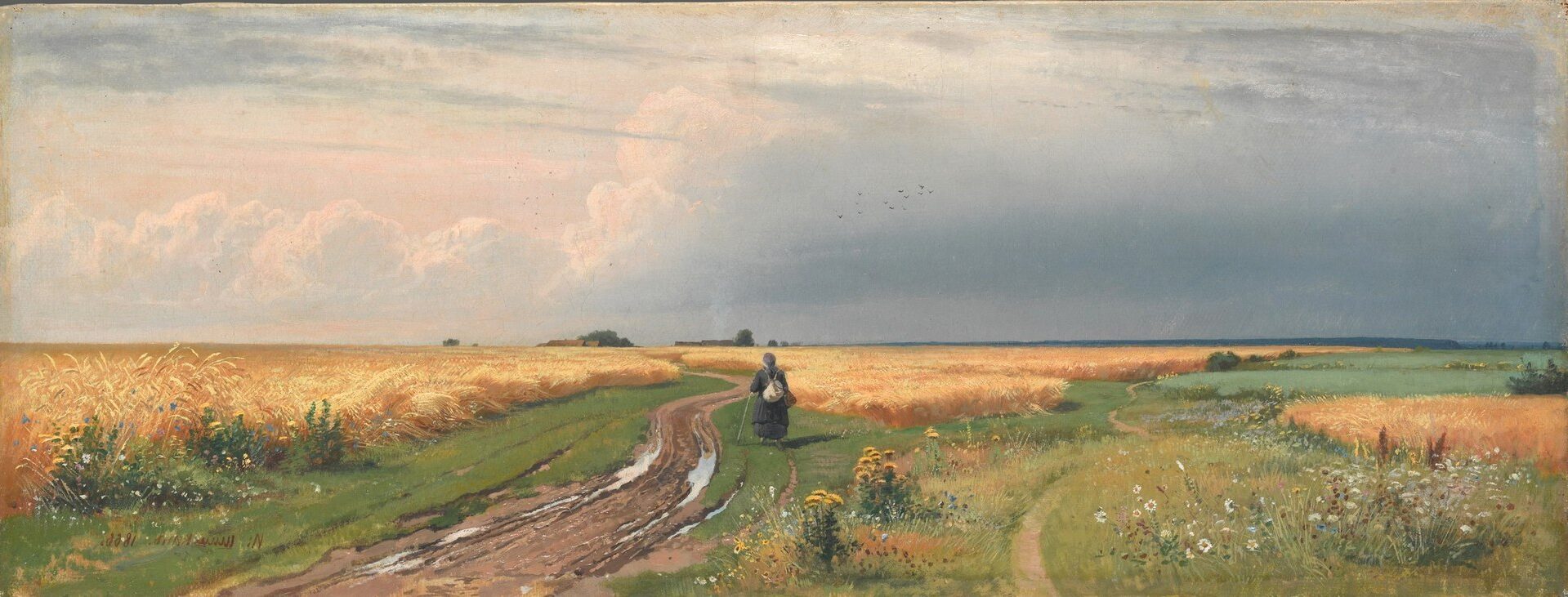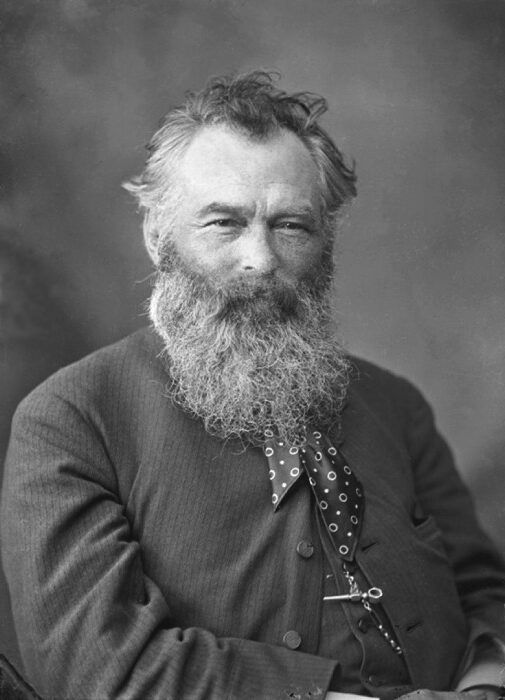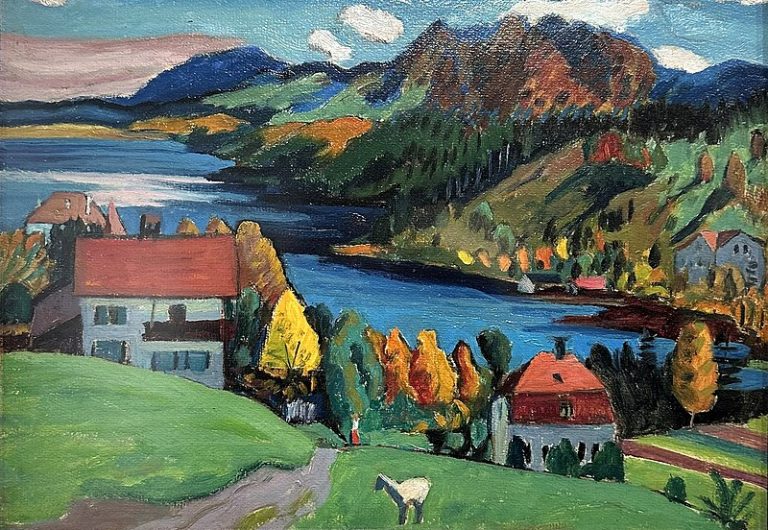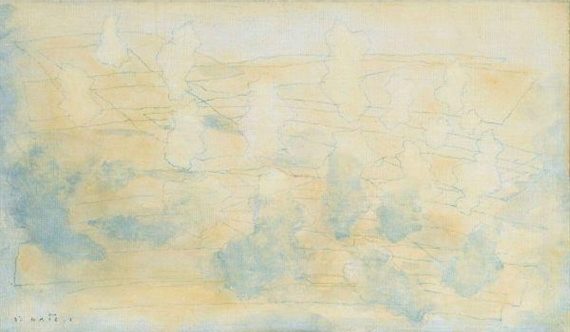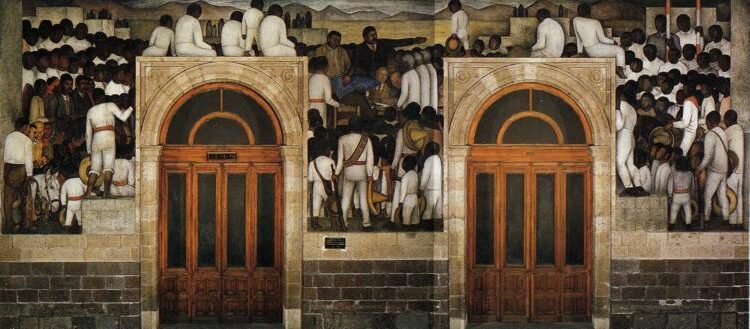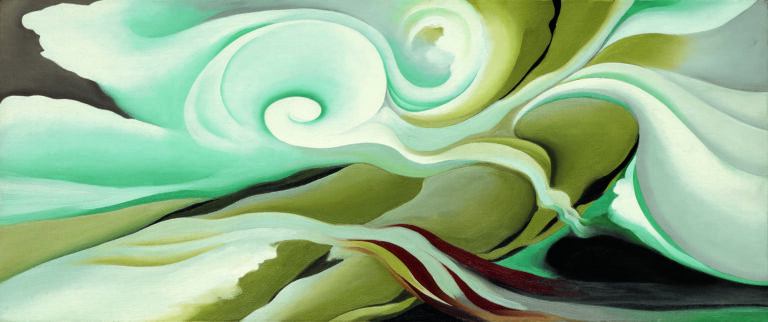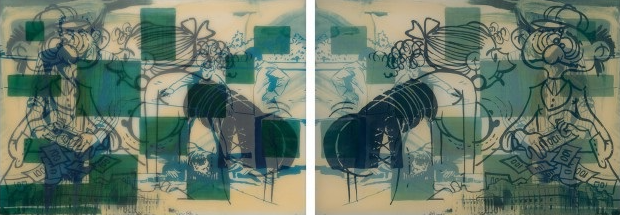Ivan Shishkin Painter: Master of Russian Landscape Art
Born: 25 January 1832, Vyatka Governorate, Russian Empire
Death: 20 March 1898, St. Petersburg, Russian Empire
Art Movement: Realism, Peredvizhniki
Nationality: Russian
Teacher: Sokrat Vorobyov
Institution: Moscow School of Painting, Sculpture and Architecture and Saint Petersburg Imperial Academy of Arts
Ivan Shishkin Painter: Master of Russian Landscape Art
Life and Career of Ivan Shishkin
Ivan Ivanovich Shishkin (1832-1898) rose from humble beginnings to become one of Russia’s most celebrated landscape painters. His detailed forest scenes earned him the nickname “tsar of the woods” among his contemporaries.
Early Life and Education
Born in 1832 in Yelabuga in the Vyatka Governorate (now part of the Republic of Tatarstan), Shishkin showed artistic talent from a young age. He began sketching as a child, capturing the natural world around him with remarkable precision.
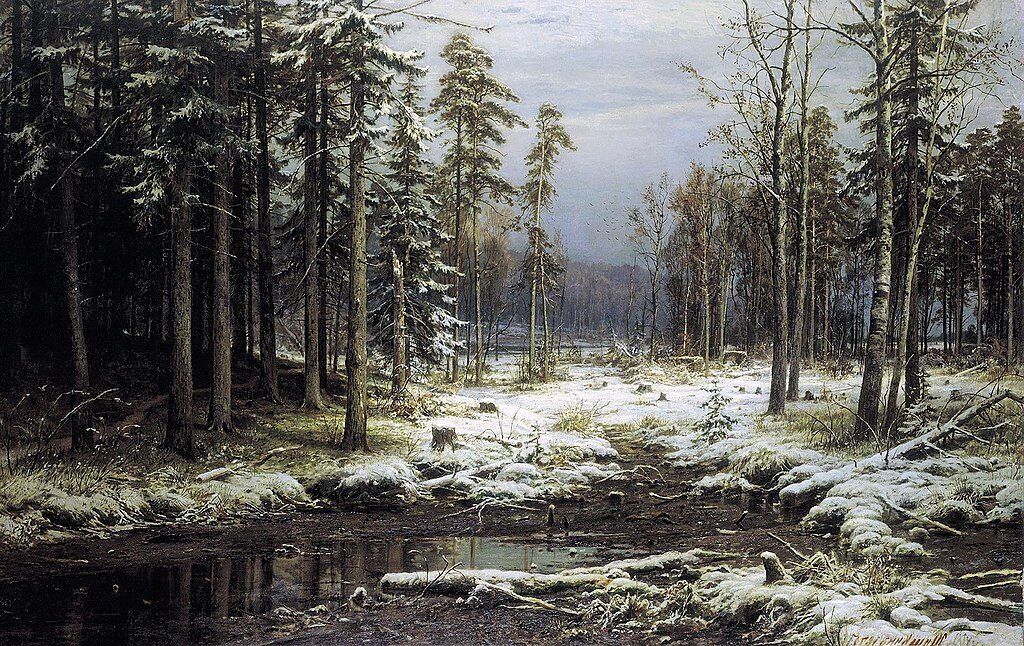
First Snow, 1875, by Ivan Shishkin
His formal education began at the Kazan Gymnasium where his early artistic abilities were recognized. Despite his father’s initial resistance to an artistic career, Shishkin pursued his passion by enrolling at the Moscow School of Painting, Sculpture and Architecture in 1852.
After Moscow, he continued his studies at the Saint Petersburg Imperial Academy of Arts from 1856 to 1860. His exceptional talent earned him a Gold Medal and an Imperial Scholarship which allowed him to further his studies in Europe.
Rise to Prominence
Shishkin’s return to Russia marked the beginning of his ascent in the art world. His meticulous attention to detail and technical mastery quickly distinguished him from his peers.
In 1873, he received the title “professor of landscape painting” for his masterpiece “Forest Wilderness,” cementing his reputation as a leading artist. From 1873 to 1898, he served as a professor at the Saint Petersburg Imperial Academy of Arts, influencing a generation of Russian painters.
His participation in numerous exhibitions throughout Russia helped spread his fame. Shishkin’s works were characterized by their photographic realism and deep understanding of forest ecosystems.
Contributions to Russian Art
Shishkin revolutionized Russian landscape painting with his scientifically accurate yet poetically powerful forest scenes. Unlike many contemporaries, he focused intensely on Russia’s native woodlands rather than exotic locales.

After the Storm in Meri Hovi, 1891, by Ivan Shishkin
His paintings celebrated the majesty of Russian nature and helped establish a distinctly national artistic identity. Works like “Morning in a Pine Forest” became iconic representations of the Russian landscape.
Shishkin’s technical innovations included an unprecedented approach to light filtering through trees and detailed botanical accuracy. His sketches and studies of plants and trees were so precise they could be used for scientific illustration.
Despite personal tragedies, including the loss of his wife and children, Shishkin remained productive until his death in 1898. His legacy endures through his 140+ major paintings and his influence on generations of Russian landscape artists.
Artistic Style and Techniques
Ivan Shishkin distinguished himself through meticulous detail and photographic realism in his landscape paintings. His analytical approach to nature and mastery of light effects created works of remarkable depth and authenticity.
Landscape Painting Mastery
Shishkin earned the nickname “Czar of the Forest” for his exceptional ability to capture woodland scenes with remarkable precision. His forest landscapes feature intricate details of pine trees, undergrowth, and natural light filtering through dense foliage.
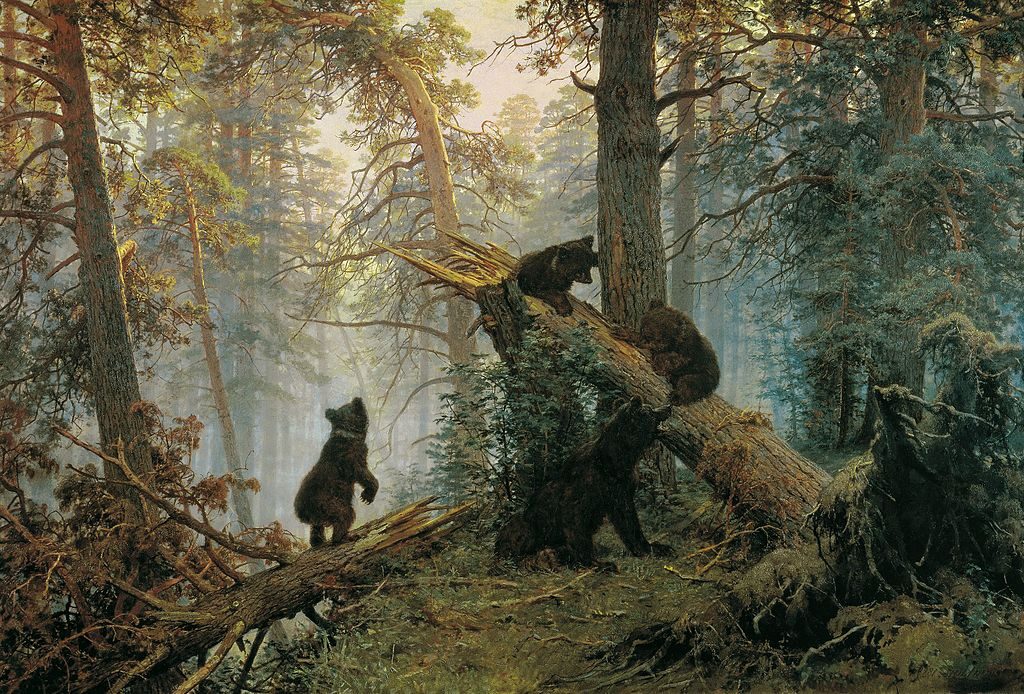
Morning in a Pine Forest, 1889, by Ivan Shishkin
Each painting demonstrates his extraordinary understanding of forest ecosystems.
Shishkin’s work often depicted Russian forests in various seasons, showing their changing atmosphere and character. His ability to render different textures—rough tree bark, soft moss, and delicate leaves—created immersive visual experiences for viewers.
His compositions typically balance wild nature with a sense of order, creating harmonious scenes that celebrate the majesty of Russia’s natural heritage. Animals and birds occasionally appear in his paintings, adding life to his carefully structured environments.
Technique and Methodology
Shishkin’s painting method was grounded in analytical observation of nature. He created numerous detailed sketches and studies before beginning his major works. This scientific approach helped him achieve unprecedented realism in his final paintings.
For large studio paintings, Shishkin used zinc white pigments, influenced by his training in Düsseldorf with German painting materials. His technique involved building layers of paint to achieve depth and dimension in his landscapes.
Beyond oil painting, Shishkin mastered the art of etching, creating detailed forest scenes that showcased his draftsmanship. His drawings reveal exceptional technical skill and attention to minute details of plant structures.
He excelled at capturing the effects of sunlight filtering through trees, creating a poetic atmosphere while maintaining strict accuracy in representation. This balance between poetry and precision defines his unique artistic vision.
Influence and Legacy
Shishkin revolutionized Russian landscape painting by elevating it to new heights of technical excellence. His work established a standard for realism in natural scenes that influenced generations of Russian artists.

At the Edge of the Pine Forest, 1897, by Ivan Shishkin
His methodical approach to landscape painting created a bridge between academic traditions and the emotional connection to Russia’s natural environment. This combination resonated with the cultural identity of the nation.
Modern digital artists continue to reference Shishkin’s style, as seen in Midjourney representations that capture his realistic and detailed approach to landscapes. His influence extends beyond traditional art into contemporary digital creation.
Shishkin occasionally incorporated human figures into his landscapes, though they typically remain secondary to the dominant natural elements. This technique highlighted the relationship between humans and the grand scale of nature.
Associations and Exhibitions
Ivan Shishkin’s artistic career was significantly enhanced through his affiliations with various art movements and participation in prestigious exhibitions. His work gained widespread recognition both within Russia and internationally through these important connections.
The Itinerants and Other Movements
Shishkin was a prominent member of the Peredvizhniki (The Itinerants or The Wanderers), a progressive group of Russian realist artists who broke from academic restrictions. This influential association, formed in 1870, focused on depicting Russian life and landscapes with unprecedented authenticity.
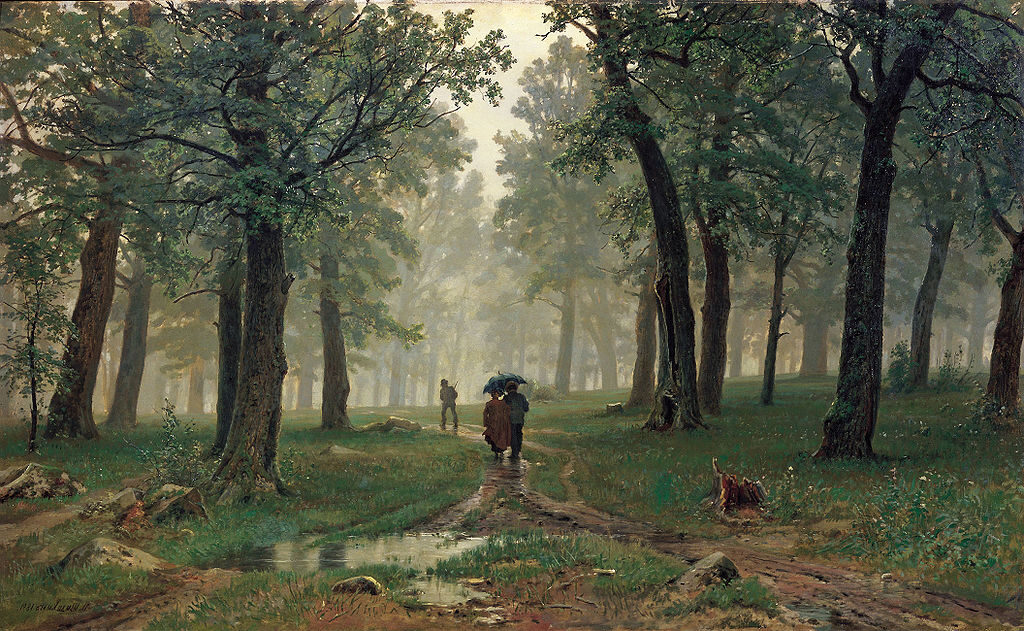
Rain in an Oak Forest, 1891, by Ivan Shishkin
While at his dacha in Vyra, Shishkin created many works that embodied the Itinerants’ mission of portraying Russia’s natural beauty. His dedication to realistic forest scenes made him a central figure in the Circle of the Itinerants.
Shishkin also maintained connections with the Society of Russian Watercolorists, though he was primarily known for his oil paintings. His technical precision and dedication to naturalistic representation earned him significant respect among Russian landscape painters of the period.
Notable Displays and International Recognition
Shishkin regularly exhibited his works at the Imperial Academy of Arts, demonstrating his mastery of landscape painting. His participation in the All-Russian Exhibition in Moscow (1882) and the Nizhniy Novgorod Exhibition (1896) cemented his reputation within Russia.
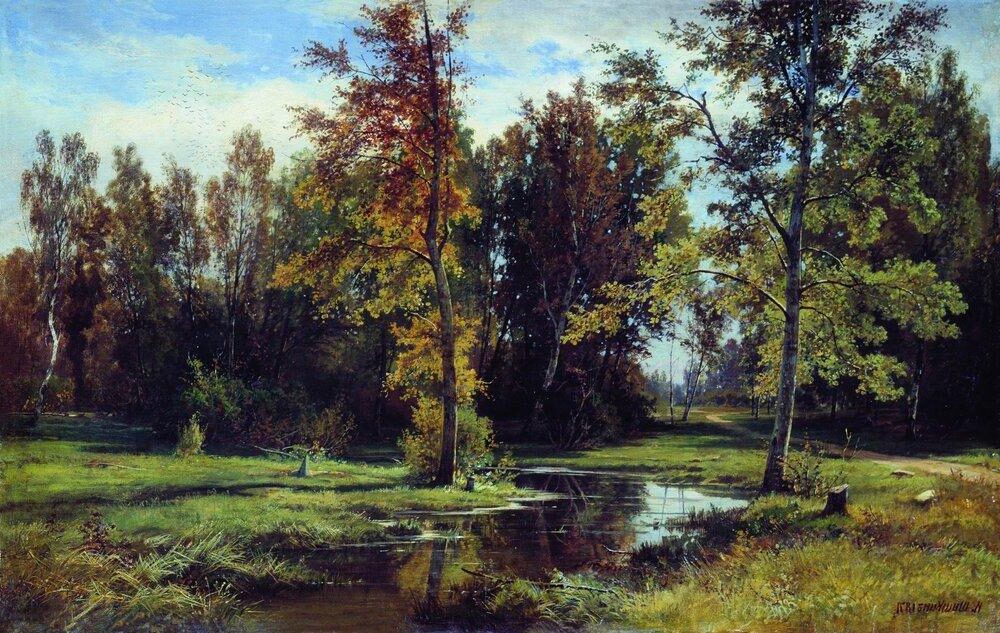
Birch Forest, 1871, by Ivan Shishkin
On the international stage, Shishkin’s paintings were featured at several World Fairs, including those in Paris, Vienna, and Prague. These exhibitions introduced his distinctively Russian landscapes to foreign audiences who appreciated his technical skill and attention to detail.
Many of Shishkin’s most celebrated works now reside in the State Russian Museum in St. Petersburg, where they continue to showcase his significant contribution to Russian landscape art. His paintings earned medals at multiple exhibitions, confirming his status as one of Russia’s most distinguished artists.
Frequently Asked Questions
Ivan Shishkin’s remarkable artistry generates many questions about his techniques, style, and legacy. His precise depictions of Russian forests and landscapes continue to captivate art enthusiasts worldwide.
What are the defining characteristics of Ivan Shishkin’s painting style?
Shishkin’s painting style is characterized by extraordinary attention to detail, particularly in his forest scenes. He meticulously rendered every tree, branch, and leaf with scientific precision.
His work demonstrates a masterful understanding of light as it filters through forest canopies. This technical precision earned him the nickname “Czar of the Forest” among his contemporaries.
Shishkin typically painted realistic landscapes with a focus on native Russian forests. His compositions often feature deep perspectives and a harmonious balance between wilderness and natural order.
Where can one find a gallery of Ivan Shishkin’s landscape works?
The Tretyakov Gallery in Moscow houses the largest collection of Shishkin’s paintings. This prestigious institution displays many of his most famous works, including “Morning in a Pine Forest.”
The Russian Museum in Saint Petersburg also maintains an excellent collection of his landscape paintings. These two museums offer the most comprehensive viewing experience of his artistic legacy.
Several international museums and online digital archives also feature his works. Major art websites and museum digital collections provide accessible galleries of his paintings for those unable to visit Russia.
What distinguishes Ivan Shishkin’s winter landscapes from those of other artists?
Shishkin’s winter landscapes stand out for their remarkable realism and technical precision. He captured the textures of snow-laden branches and ice-covered surfaces with exceptional accuracy.
Unlike some contemporaries who emphasized the harshness of Russian winters, Shishkin often found beauty and tranquility in winter scenes. His winter forests maintain a sense of life and vitality despite the seasonal dormancy.
Shishkin used a distinctive palette for winter scenes, accurately capturing the subtle blues, grays, and whites that characterize the Russian winter landscape.
How did Ivan Shishkin influence the Russian art movement of his time?
Shishkin was a founding member of the Peredvizhniki (The Wanderers), a progressive art movement that rejected academic restrictions. This group sought to create distinctly Russian art that connected with ordinary people.
His dedication to plein air painting inspired many Russian artists to work directly from nature. This approach revolutionized landscape painting in Russia during the 19th century.
Shishkin’s celebration of Russian forests helped develop a national artistic identity. His work embodied the movement’s goals of depicting authentic Russian landscapes rather than idealized European scenes.
Which museums house the most significant collections of Ivan Shishkin’s works?
The State Tretyakov Gallery in Moscow contains the world’s largest collection of Shishkin’s paintings. This includes his iconic work “Morning in a Pine Forest” featuring bears in a forest setting.
The State Russian Museum in Saint Petersburg holds numerous important pieces by Shishkin. Their collection showcases the development of his artistic style throughout his career.
Several regional Russian museums also display notable Shishkin works. The Kirov Regional Art Museum and the Kazan Art Museum have significant collections related to areas where Shishkin lived and worked.
What techniques did Ivan Shishkin employ to achieve realism in his paintings?
Ivan Shishkin used plein air sketching and drawing from nature to capture authentic details of the Russian landscape. He relied on this practice before completing larger works in his studio.
He also developed exceptional skills in rendering different textures found in forests. His technique for painting bark, leaves, moss, and water created convincingly realistic natural environments.
In addition, Shishkin often used a limited palette dominated by earthy greens and browns. This color discipline helped create the unified, natural appearance that makes his forest scenes so convincing.

